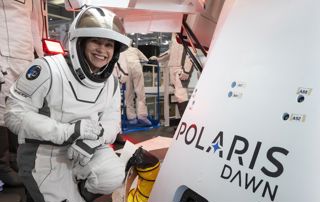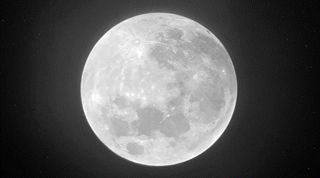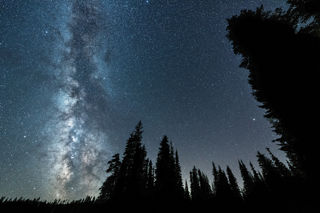
What's Happening in Space: July 2024
- 1st Jul 2024
- Author: Grace Davis
A summary of space events through the month
Dhara Patel is a Space Expert at the National Space Centre, working to help share space science, stories, and topical news with our visitors and online audiences. Each month she curates a round-up of some notable space and science events coming up the weeks ahead.
There are some great events coming up this June, including a SpaceX Starship test flight, a full moon just after the summer solstice, and the launch of the SVOM French-Chinese mission...
July – Spot Comet 13P/Olbers
After reaching perihelion (closest approach to the Sun) at the end of last month, comet 13P/Olbers which is making its 69-year visit to the inner solar system, might still be worth looking for in early July. It will be too faint to see with the naked eye but potentially visible using a small pair of binoculars (with an aperture of 50mm). Throughout June it brightened and travelled from the constellation of Auriga into Lynx sitting low in the northwest around sunset. Throughout July and into August viewed around twilight, it will climb higher into the sky as it moves from Lynx to between the constellations Ursa Major and Leo Minor, but it will also become fainter during this time. The comet may be seen as a pale fuzzy patch consisting of a small nebula with a bright centre and its tail could be discernible.

1st July / 30th July – Moon and Mars close in the sky
On the evening of 1st July, the waning crescent moon will be in conjunction (sharing the same right ascension – coordinate) with Mars, but the pair will be below the horizon at this time, so not visible from the UK. They will also be at their closest angular separation (close approach) as they dip below the western horizon on that day so instead try to catch the Moon and Mars in close proximity just before sunrise in the east. Before sunrise on the 1st July, the Moon will appear to the right of Mars or at dawn on 2nd July the Moon will have move to the left of Mars. A clear view without tall buildings or trees that may block your view will help you spot the pair more easily. The Moon will again be in conjunction with Mars and reach their closest angular separation on the morning of 30th July (in the daytime sky) – so once more will not be visible at this time. Look for the pair in close proximity before sunrise on 30th July in the east when the Moon will be positioned slightly above the red planet. Find out more about conjunctions, close approaches and other astronomical phenomena in our blog written by David Southworth in our Education Team: https://www.spacecentre.co.uk/news/space-now-blog/astronomical-phenomena/.
3rd July / 31st July – Moon and Jupiter close in the sky
On the morning of 3rd July, the very thin waning crescent moon will be in conjunction (sharing the same right ascension – coordinate) with Jupiter, but being up in the daytime sky, the pair won’t be visible from the UK. So instead try to catch the Moon and Jupiter in close proximity just before sunrise on this day in the northeast. They’ll be low on the horizon, with the Moon position slightly above Jupiter in the sky, so you’ll need an extremely clear view without tall buildings or trees that may block your view. They’ll again be in conjunction just after midnight on 31st July but will still be below the horizon at this time. Once again, you can instead look for the pair in close proximity just before sunrise – look towards the east to spot the Moon to the left of Jupiter. Check out the astronomical phenomena blog linked above to find out more about conjunctions, close approaches and occultations.
5th July – new moon (11:58pm)
The new moon will occur in the constellation of Gemini. We have a blog on ‘phases of the moon’ written by Mike Darch in our Space Comms team: https://spacecentre.co.uk/blog-post/moon-phases/
9th July – Debut launch of ESA’s Ariane 6 rocket
For more than a quarter of a century, ESA’s Ariane 5 rocket flew 117 flights before retiring in 2023. It has launched missions like the James Webb Space Telescope and the JUICE mission currently heading to Jupiter. Succeeding Europe’s principal launch system is Ariane 6 which will also launch from Europe's Spaceport in French Guiana. Its debut has been delayed but it’s now set to make its inaugural flight on 9th July (7:00pm UK-time) and will be carrying six small satellite payloads on this demonstration flight. While Ariane 6 won’t be reusable like some of its competitors (e.g. SpaceX Falcon 9), its ability to carry larger payloads and more notably it’s re-ignitable second stage engine place it in the big league. This ability to restart its engine will allow Ariane 6 to deploy multiple payloads into different Earth orbits on a single flight. Check out this blog on ESA’s brand new launch vehicle, Ariane 6, written by Ed Turner in our Education team: https://www.spacecentre.co.uk/news/space-now-blog/ariane-6-europes-newest-launch-vehicle/

12th July – Polaris Dawn mission
In this first mission of the Polaris Program, named Polaris Dawn, the four astronauts on board will achieve the highest Earth orbit by a crewed spacecraft since Gemini 11 in 1966. It will also attempt the first spacewalk by a private astronaut. Funded and commanded by the billionaire Jared Isaacman, the mission will be operated by SpaceX – using a modified crew dragon module and new EVA (Extra Vehicular Activity) spacesuits. Polaris Dawn is scheduled to launch no earlier than 12th July from Cape Canaveral Space Force Station, USA on a Falcon 9 rocket. Joining Isaacman will be pilot Scott Poteet, and mission specialists Sarah Gillis and Anna Menon. They will spend up to five days in orbit supporting scientific research designed to advance both human health on Earth and our understanding of human health during future long-duration spaceflight, and they’ll be the first to test Starlink laser-based communications in space. Find out more about the Polaris Dawn mission in this blog by Ed Turner in our Education team: https://www.spacecentre.co.uk/news/space-now-blog/polaris-dawn/
Image credit: SpaceX, https://www.flickr.com/photos/spacex
21st July – full moon (11:17am)
Known as the Buck moon (according to the old Farmers’ Almanac), this full moon is named after bucks (male deer) who would start to regrow their antlers at this time of year. Check out the “Full Moon: Full Facts” blog written by Mike Darch in our Space Comms team: https://spacecentre.co.uk/blog-post/full-moon-facts/.
22nd July – Mercury at greatest eastern elongation
Mercury will be at its furthest separation from the Sun on 22nd July when it reaches greatest eastern elongation, making it a great time to try and spot the Sun’s closest planet. Look to the west around sunset – it will be close to the western horizon in the constellation of Leo, so you’ll need a clear view without tall buildings and trees. Check out the astronomical phenomena blog linked above to find out more about greatest elongations.
24th July – Moon and Saturn close in the sky
On the evening of 24th July, the waning gibbous moon will be in conjunction (sharing the same right ascension – coordinate) with Saturn, but they’ll be below the horizon at this time, so not visible from the UK. They will also be at their closest angular separation (close approach) whilst below the horizon so instead try to catch the Moon and Saturn in close proximity as they rise above the southeastern horizon closer to midnight. The Moon will appear to the left of Saturn, and they’ll be visible throughout the night after rising around 11pm. The pair will be lower on the horizon earlier in the night, calling for clear view without tall buildings or trees that may block your view, and will appear higher in the sky as dawn approaches but they’ll then have a greater separation in the sky. Check out the astronomical phenomena blog linked above to find out more about conjunctions and close approaches.

30th July – peak of the Delta Aquariid meteor shower
An average shower, ~ 20 meteors per hour at its peak, produced by dust left behind by comet 96P/Machholz. The peak isn’t clearly defined but the early morning of 30th July is likely the best time to observe (though you can observe from the evening before through till just before dawn). Light from the waning crescent moon which rises around 1:00am may interfere with your meteor-gazing efforts, but it’s still worth viewing from as dark a location as possible especially if you head out after midnight on 30th July when the constellation of Aquarius (where the radiant lies) will be higher in the south. Find an open location with clear views of the horizon and face south looking away from the radiant and scanning the entire starry canvas above as meteors can appear anywhere in the sky. Check out the Delta Aquariid meteor shower blog written by Lucy Spencer in our Community team: https://www.spacecentre.co.uk/news/space-now-blog/delta-aquariid-meteor-shower-2024/
Image credit: Diana Robinson, https://www.flickr.com/photos/dianasch/
July?? – SpaceX Starship – Test Flight 5
Starship is made up of the Super Heavy booster – a first stage rocket with 33 of SpaceX’s raptor engines, and on top of that sits the upper stage - rather confusingly also called Starship (which hosts 6 engines). And when its fully developed, this launch vehicle will be a completely reusable rocket – both first and second stages. A modifies version of Starship is currently planned to land astronauts on the Moon with the Artemis 3 mission.
- Test flight 5 is currently scheduled for some time in July, from SpaceX’s launch facility, Starbase, in Boca Chica, Texas, United States. After the successful booster splashdown during the last test flight, Musk stated that SpaceX would attempt to catch the booster with the tower on Flight 5 (to demonstrate reusability for the first time), but that is yet to be confirmed.
Find out more about Starship and SpaceX’s other rocketry achievements in this blog by Ed Turner in our Education team: https://www.spacecentre.co.uk/news/space-now-blog/spacex-the-world-s-rocket-giant/
DETAILS OF PREVIOUS TEST FLIGHTS
- The first test flight of the fully integrated Starship rocket took place on 20th April 2023 - the upper stage failed to separate from the booster a few minutes into its flight and SpaceX experienced a ‘rapid unscheduled disassembly’ a.k.a. RUD / an explosion.
- During the second test flight on 18th November 2023 the stages separated but shortly after, the first stage had multiple engine failures and after beginning its boost back burn, ended up exploding. Meanwhile the Starship second stage continued to fly for over 8 minutes, but an anomaly caused the flight termination system to kick in, so it too was destroyed after reaching an altitude of 148 km.
- The third test flight on 14th March 2024 was more successful with the first stage and second stage separating successfully. The Super Heavy first stage then returned to Earth and lit several engines for its first ever landing burn, before the vehicle experienced a RUD about 462m in altitude, after just under seven minutes into the mission. Starship’s second stage completed its ascent burn, then opened and closed its payload door and initiated a propellant transfer demonstration in space. It then underwent re-entry with live views showing the heating experienced on the craft due to the hypersonic speeds on descent. The ship experienced a heavy roll causing SpaceX to lose attitude control, resulting in the loss of the vehicle with last telemetry received around 49 minutes into the flight.
- The fourth test flight on 5th June had the main aim of bringing Starship's first-stage Super Heavy booster down for a soft splashdown in the Gulf of Mexico, and to achieve a controlled re-entry of the Starship upper stage and both appeared to make their water landings.
Please note: As this summary is created at the end of the month before, dates (especially launch dates) can often change or be updated, so this content may become outdated - we always recommend checking on the relevant organisation's pages.
